Authentic Cornish Pasty Recipe
This post may contain affiliate links. See my disclosure policy.
The national dish of Cornwall, England, this authentic Cornish Pasty recipe features savory flaky pastry pockets filled with beef and vegetables. Cornish pasties have a long and fascinating history and are the very essence of comfort food. Learn how to make a Cornish pasty the authentic and traditional way.

I love Great Britain. I lived in Cambridgeshire, England for nearly 7 years and my husband spent 2 years in Liverpool and north Wales. We’re both Anglophiles through and through and go back at least once a year for a visit with our kids. We love every area of Great Britain and it’s hard to pinpoint a favorite area. But Cornwall holds a very special place in our hearts and no matter where else in England we’re visiting, we always make time for a visit to Cornwall.
A Brief Cornish Family History
We love Cornwall not only because of its striking natural beauty, rustic charm and rich culture, but also because it’s home to my husband’s namesake ancestors, the Killigrew family (later changed to Killebrew when his great+ grandfather immigrated to the U.S.). The Killigrews were landed gentry and one of the most prominent families in Cornwall. They founded the port town of Falmouth, built and lived in Arwenack Manor, and were the royally appointed de facto captains of Pendennis Castle. We always look forward to a return visit to these family sites including St. Budock church where the Killigrew family held front row seats, are buried beneath the floor in front of the altar, and where a well-known painted wall edifice stands depicting Todd’s great+ grandparents kneeling in prayer towards each other.
I can’t claim as close (or as impressive) of an association to Cornwall as Todd, unfortunately. But I do have a great+ grandmother from Scotland (wife to an admiral who regularly sailed down to Cornwall on business) who died and is buried in Cornwall. And it’s like I always say, if you’re going to die (as most people tend to do), there’s no better place to do it than in Cornwall.
With our close connection with and love for Cornwall, we also feel a close kinship with its traditional foods, the most famous of which is the Cornish pasty, considered the national dish of Cornwall.

What is a Cornish Pasty?
A Cornish pasty is a turnover-shaped baked shortcrust pastry filled with beef and vegetables. The edges are sealed by crimping them in characteristic Cornish fashion.
In 2011, Cornish pasties were given both a Protected Designation of Origin (PDO) and Protected Geographical Indication (PGI) status, which means that in order for these pasties to be made commercially and bear the name “Cornish pasty”, they have to meet very specific requirements. These requirements are as follows:
- They have to be made in Cornwall.
- They can only contain beef, potato, Swede (rutabaga), onion, salt and pepper. No other meat, no other vegetables, no other seasonings allowed.
- The ingredients must be raw when the pasties are assembled and then slowly baked to produce the traditional Cornish pasty flavor and texture.
- The edges of the pasties must be sealed by crimping them in traditional Cornish fashion.
No culinary license allowed here and any deviations from these parameters will land you in stocks at the market square for public shaming. Well, that may be a stretch. But you will incur a fine.

The Origin of the Cornish Pasty
The Cornish pasty has a unique and interesting history that goes back centuries. Cornwall had the biggest tin mining and one of the biggest copper mining industries in the world and the pasties were originally developed for Cornish miners. These men worked deep underground and needed a lunch that would meet the demands of their work environment. The thick shortcrust dough and dense filling would stay warm for several hours until lunchtime or could be easily reheated over the flame of an oil lamp.
The pasties were sealed with a thick crimp to hold in the contents and to provide something the miner’s could hold onto while eating the pasty. In this way their dirtied fingers, which could often contain traces of arsenic, wouldn’t contaminate the rest of the pasty. The crimped edge was sometimes extended out to form a little dough handle they could hold onto and then discard when they were done eating.
The filling was a hearty one that provided needed sustenance and the pasty was compact enough that it could easily be carried in a small lunchbox down the mine and eaten without utensils. Some historians also believe that the miner’s initials would sometimes be engraved in the dough at one end of the pasty so that if the miner didn’t finish it in one sitting they could easily identify it as their own.
Thoughtful wives would even take their ingenuity a step further and make pasties that were divided in two sections: One half would contain the savory filling and the other half a sweet filling for dessert. In this way the ingenious Cornish pasty was a complete meal for Cornwall’s hard-working miners.
A Few Pictures of Cornwall’s Historic Mines








Tips for Making the Best Cornish Pasties
- A good, flaky shortcrust pastry is imperative, and I’m sharing my shortcrust recipe with you below that will ensure excellent results.
- Depending on how thin you roll out your shortcrust pastry you risk having the “hard” ingredients (the potatoes and rutabagas) pierce through the dough. If you prefer a thinner crust and you want to avoid that you can place the softer ingredients on the top and bottom with the harder ingredients sandwiched in the middle: Place the onions on the bottom followed by the potatoes and rutabagas and then the meat on top.
- Use firm, waxy potatoes so they hold their shape. Starchy potatoes will disintegrate during baking and turn mushy.
- Use a lean cut of beef. Traditional Cornish pasties use skirt steak from the underside belly of the cow because it’s lean and free of gristle.
- Add a couple of pats of butter on top of the filling ingredients followed by a light sprinkling of flour. This will both form the gravy as well as absorb the liquids from the vegetables as their cooking to avoid a soggy pastry crust.

Cornish Pasty Recipe
Let’s get started!
First make your shortcrust pastry:
Place the flour and salt in a food processor and pulse a few times until combined. Add the cold butter and lard and pulse a few more times until the mixture resembles coarse crumbs.
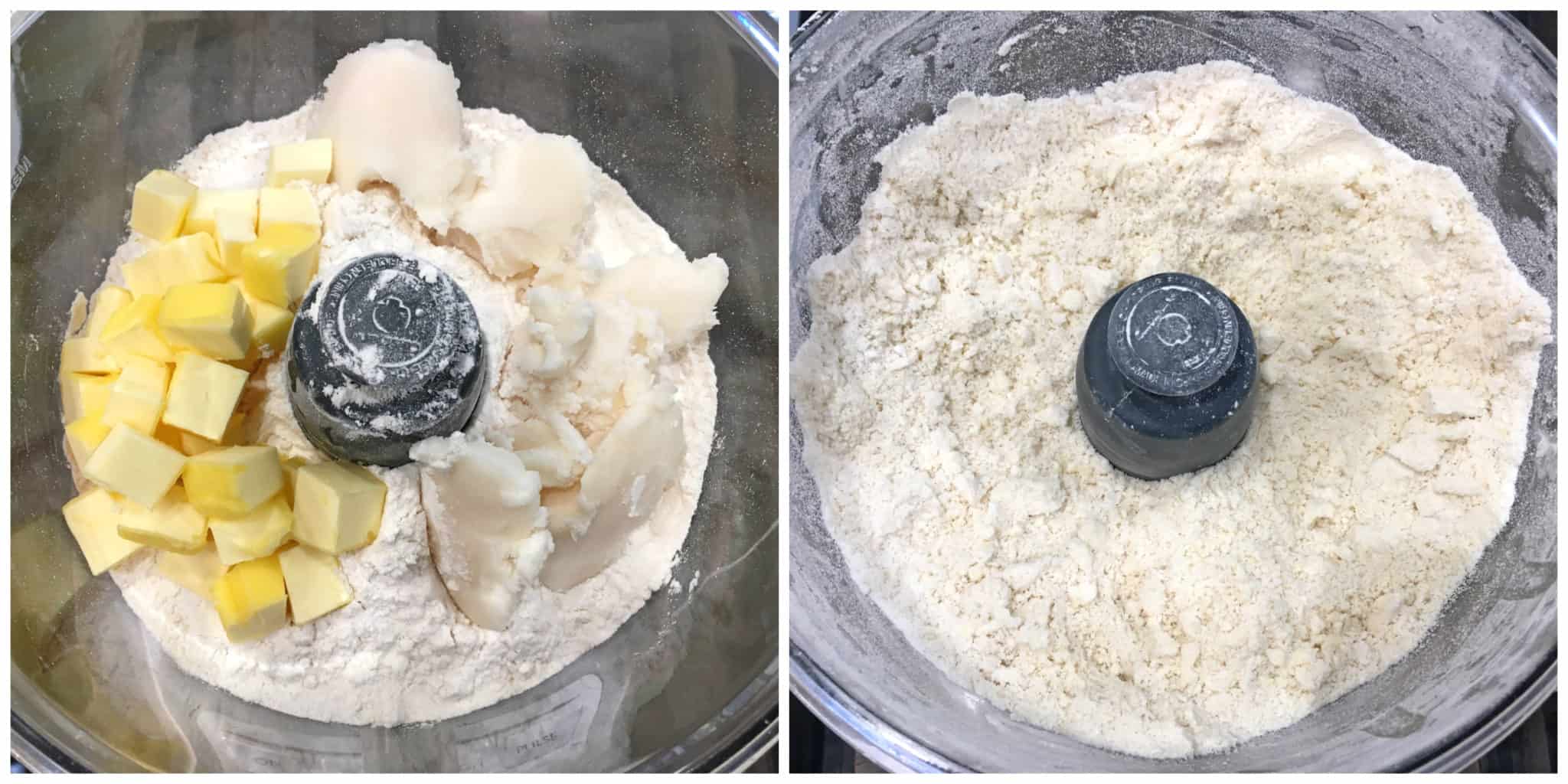
Add the water a little at a time, pulsing between additions, until the mixture begins to come together. DO NOT over-mix the dough or the pastry crust will be tough and won’t be flaky.

Form the dough into a ball, flatten into a 1-inch thick disk, wrap in plastic wrap and refrigerate for at least 3 hours before using (this is crucial). (Can be refrigerated for a few days or frozen for up to 3 months.)
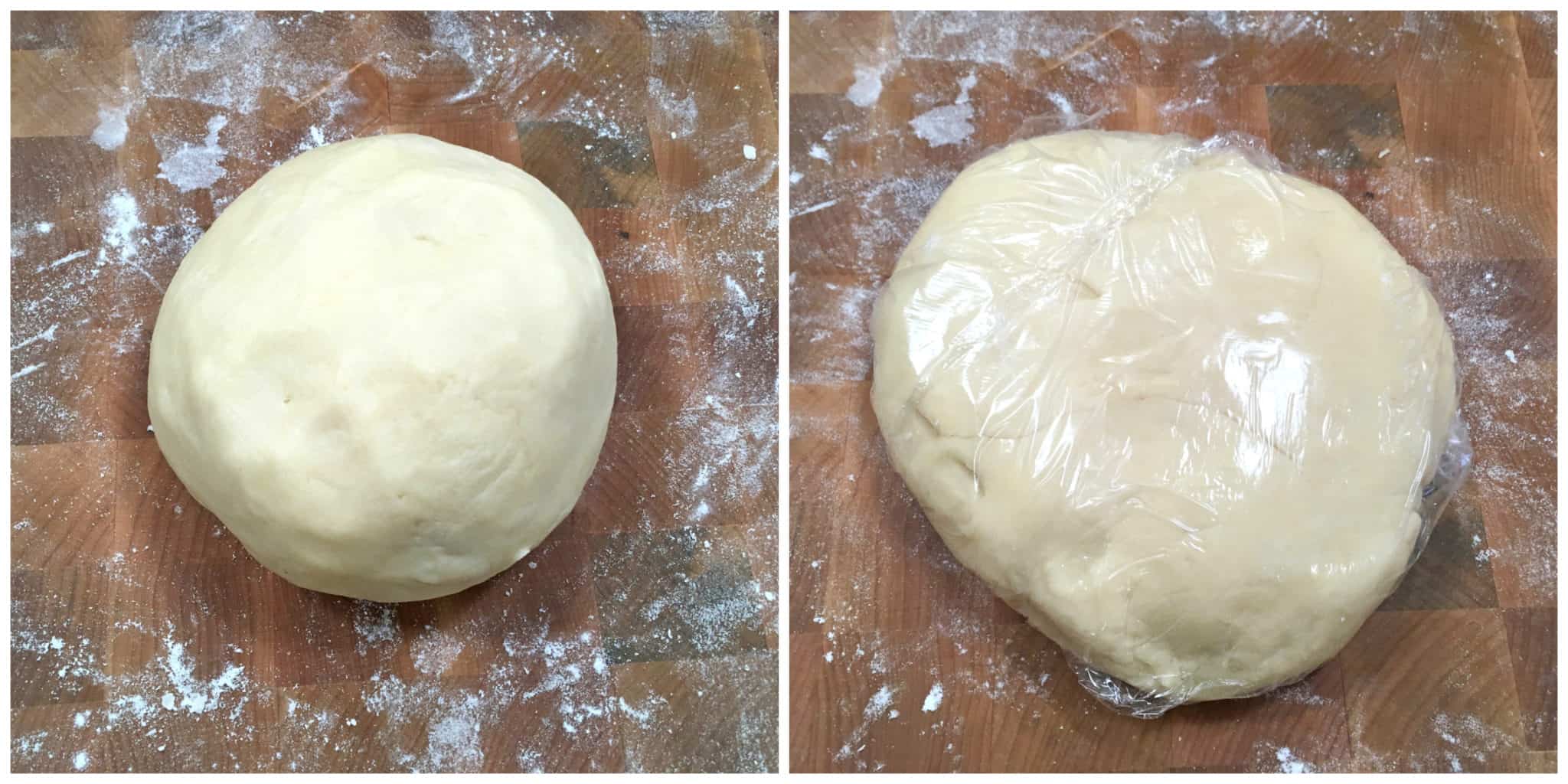
Roll the pastry dough into a log and cut it into 6 equal pieces.
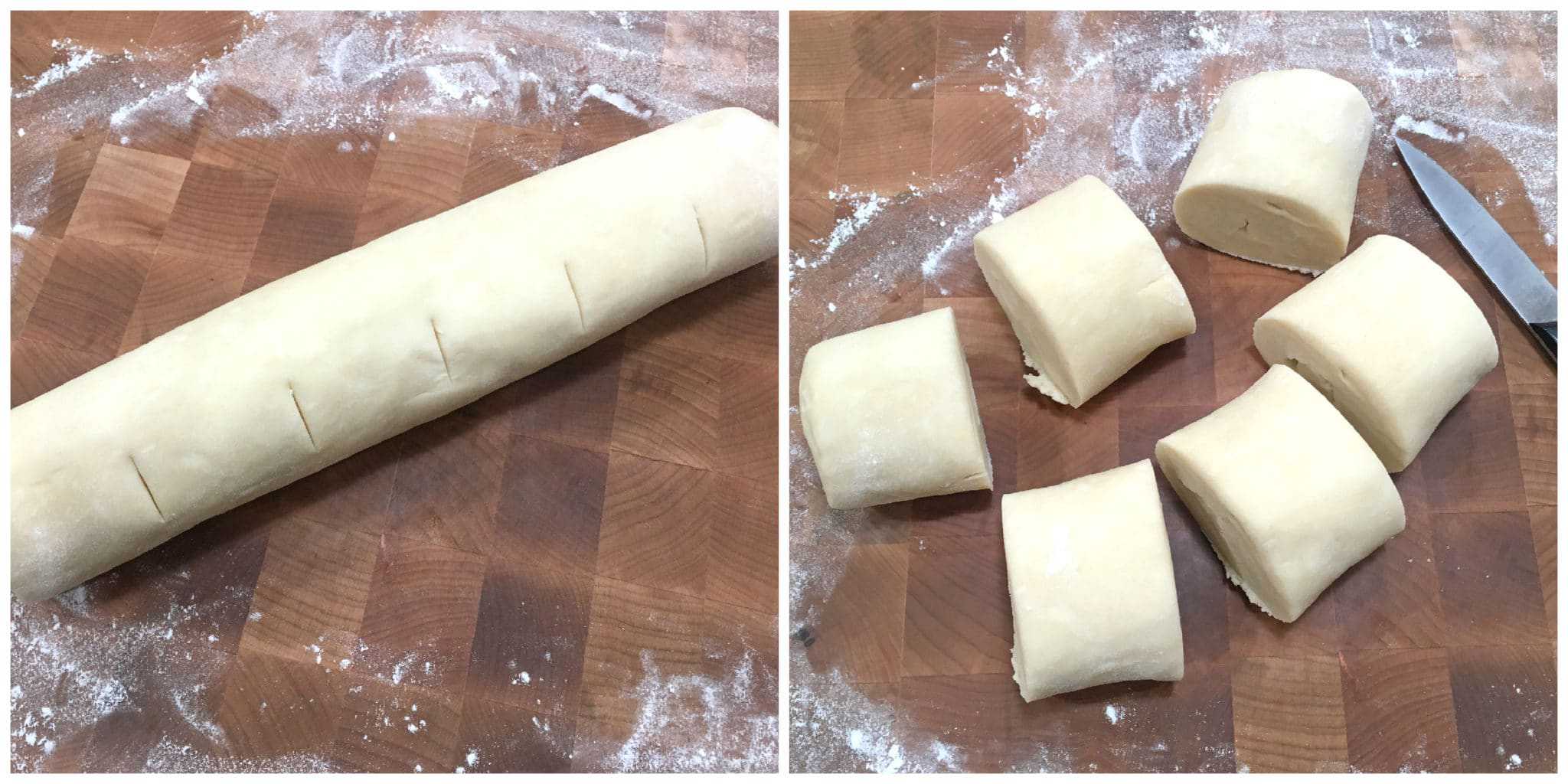
Wrap and keep the other 5 pieces chilled in the fridge while you’re working on one at a time. Roll the dough out on a lightly floured work surface to a 8 inch circle that’s about 1/8 inch thick. You can use an 8-inch plate as your guide and cut the dough around it to form your circle.

Layer the filling (each ingredient to be divided out between 6 pasties, there may be some excess remaining): Put layer of potatoes down the center of the pastry circle, leaving about 3/4 inch space on the top and bottom edges of the pastry dough. Lightly sprinkle with salt and pepper.
Next add a layer of rutabagas and sprinkle with salt and pepper.

Add a layer of beef followed by the onions and sprinkle with salt and pepper.

Lay a couple of pats of butter on top of the beef and sprinkle a little flour over the filling.

Wet the tips of your fingers and lightly moisten the edges of the pastry dough.
For the remaining steps work gently so that the filling doesn’t puncture through the dough. If this happens, patch up the hole with some of the scrap pieces of pastry dough. Bring the sides up and seal the pasty down the middle.

Turn the pasty onto its side and crimp/braid the edges in traditional Cornish fashion. This is the challenging part of making traditional Cornish pasties and takes some practice. There are some YouTube videos you can look up that show how to do this.


Assemble the remaining pasties and lay them on a lined baking sheet.
Use a sharp knife to cut a slit in the center of each pasty.

Lightly brush each pasty with the beaten egg mixture.
Bake the Cornish pasties on the middle rack for 40-50 minutes until golden in color. Remove from the oven and let them sit for about 10 minutes (they will be very hot inside) before eating.

The homemade Cornish pasties can be reheated in the oven or in microwave, but for a crispy crust I highly recommend reheating them in the oven.

Can Cornish Pasties Be Frozen?
Yes. The shortcrust pastry holds up well to freezing and thawing and the filling has little liquid which means the pasties won’t get soggy. You can freeze them either baked or unbaked, whichever you prefer. Wrap each pasty individually in plastic wrap and then store the wrapped pasties in a heavy-duty freezer bag.
If you’re freezing them unbaked it’s best to cook them while frozen – don’t thaw them first. Baking time will take roughly 15-20 minutes longer.
If you’re freezing them already fully baked and cooled then you can simply reheat them in the oven (for a crispier crust) or in the microwave and you have a quick, ready-to-go meal.
Enjoy!
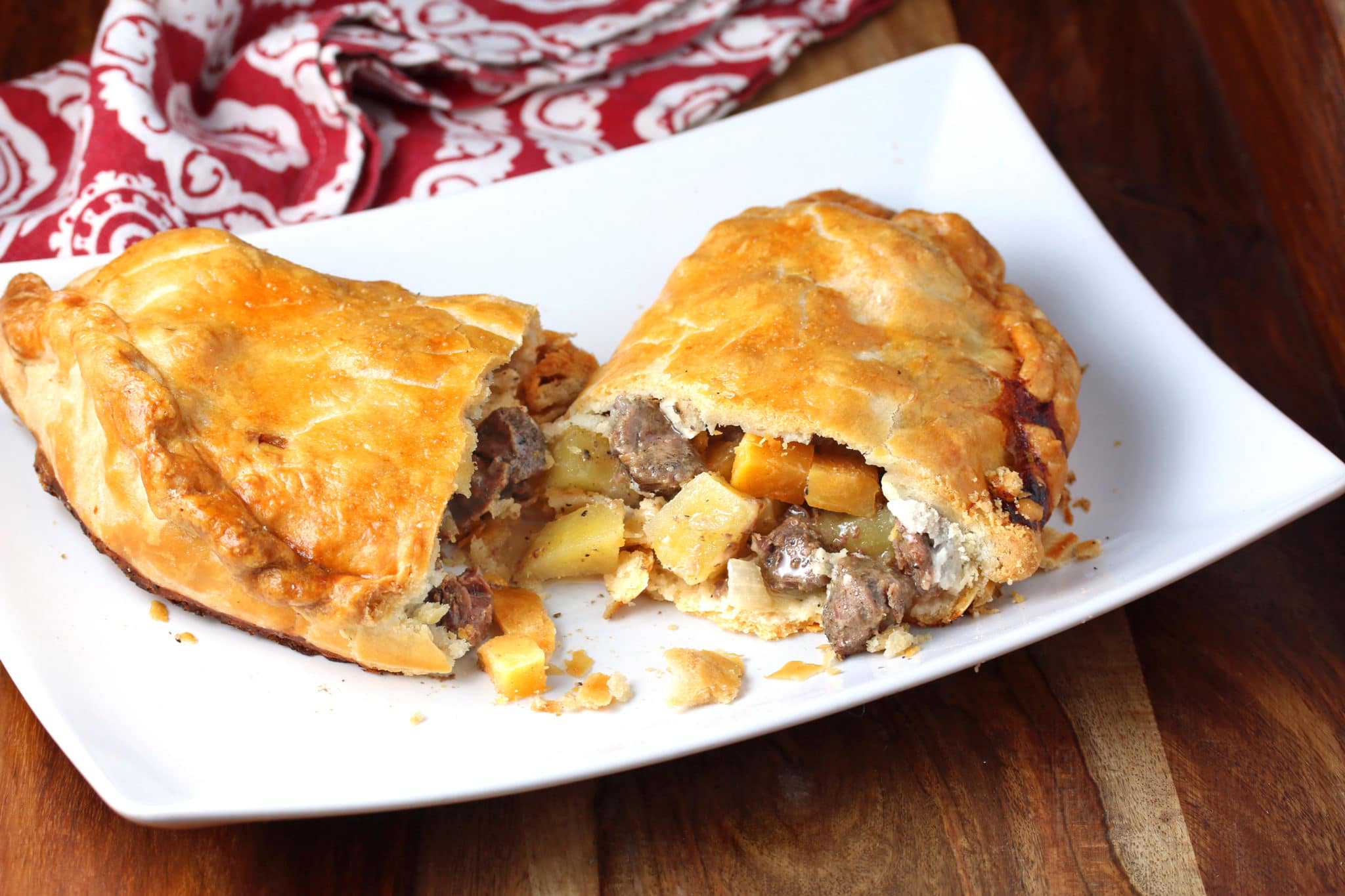
For more favorite British recipes try my:
- Fish and Chips
- Yorkshire Pudding
- Mushy Peas
- Bangers and Mash
- Scotch Eggs
- Crumpets
- Cornish Fairings
- Sticky Toffee Pudding
- Mincemeat Pie
- Beef and Guinness Stew
- Spotted Dick
- Chelsea Buns
- Toad in the Hole
- Eccles Cakes
- Scottish hortbread
- Treacle Tart
Save This Recipe
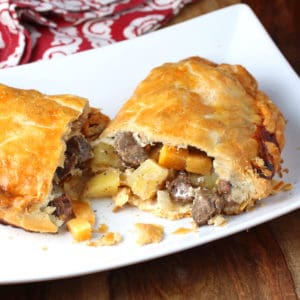
Authentic Cornish Pasty Recipe
Ingredients
For the Shortcrust Pastry:
- 3 1/2 cups all-purpose flour or bread flour (I make mine with all-purpose flour)
- 1 teaspoon salt
- 5 ounces unsalted butter , very cold, diced
- 5 ounces lard , very cold (can substitute butter but lard makes the flakiest crust)
- How to Render Lard (click link to learn how to make it yourself. It's super easy and much cheaper than store-bought!)
- 2/3 cup ice cold water
For the Cornish Pasties:
- 1 pound beef skirt steak or sirloin , cut into small cubes
- 1 pound firm, waxy potato (e.g. Yukon Gold) , peeled and diced in 1/4 inch cubes, or slice them according to personal preference (**starchy potatoes will disintegrate and turn mushy so be sure to use a firm, waxy potato that will hold its shape)
- 8 ounces rutabaga , peeled and diced in 1/4 inch cubes, or slice them according to personal preference
- 7 ounces yellow onion , chopped
- salt and pepper to taste
- unsalted butter (for cutting in slices to lay inside the pasties)
- all-purpose flour (for sprinkling inside the pasties)
- 1 large egg , lightly beaten
Instructions
- To Make the Shortcrust Pastry: Place the flour and salt in a food processor and pulse a few times until combined. Add the cold butter and lard and pulse a few more times until the mixture resembles coarse crumbs. Add the water a little at a time, pulsing between additions, until the mixture begins to come together. DO NOT over-mix the dough or the pastry crust will be tough and won't be flaky. Form the dough into a ball, wrap in plastic wrap, and refrigerate for at least 3 hours before using (this is crucial). (Can be refrigerated for a few days or frozen for up to 3 months.)
- To Make the Cornish Pasties: Preheat the oven to 350 degrees F.Cut it into 6 equal pieces (rolling the dough into a log and then cutting makes this easier). Wrap and keep the other 5 pieces chilled in the fridge while you're working on one at a time. Roll the dough out on a lightly floured work surface to a 8 inch circle that's about 1/8 inch thick. You can use an 8-inch plate as your guide and cut the dough around it to form your circle.
- Layer the filling (see note at end): Put layer of potatoes down the center of the pastry circle, leaving about 3/4 inch space on the top and bottom edges of the pastry dough. Lightly sprinkle with salt and pepper. Next add a layer of rutabagas, onions and finally the beef, adding a light sprinkling of salt and pepper between each layer. Lay a couple pats of butter on top of the beef and sprinkle a little flour over the filling.
- Wet the tips of your fingers and lightly moisten the edges of the pastry dough. For this next part work gently so that the filling doesn't puncture through the dough. If this happens, patch up the hole with some of the scrap pieces of pastry dough. Bring the sides up and seal the pasty down the middle. Turn the pasty onto its side and crimp the edges in traditional Cornish fashion (see blog post pictures as a visual).
- Assemble the remaining pasties and lay them on a lined baking sheet. Use a sharp knife to cut a slit in the center of each pasty. Lightly brush each pasty with the beaten egg mixture.
- Bake the Cornish pasties on the middle rack for 40-50 minutes until golden in color. Remove from the oven and let them sit for about 10 minutes (they will be very hot inside) before eating. They can be reheated in the oven (recommended for a crispier crust) or microwave. NOTE: Depending on how full you stuff the pasties you may have leftover filling. No worries, just fry it up together or add it to soup and enjoy it as a separate meal.
Nutrition
Originally published on The Daring Gourmet January 22, 2020



















Thank for the very nice recipe. However please note the 1X,2X,3X button does not change the metric measures.
Can I substitute Crisco instead of lard?
Yes you can, I just hate to recommend it because I avoid that stuff like the plague ;)
I agree… crisco is like margarine 10% away from plastic.. horible stuff….should be no where in a recipe
Would pizza dough be a usable replacement? I’m thinking maybe not…
Hi Allen, you “can”, but the texture would be completely different – it would be a pizza pocket and not a Cornish pasty. The flaky shortcrust pastry is one of the very best parts of a Cornish pasty.
Thank you so much for sharing such a delicious recipe. I too married and moved to the US. I was feeling homesick, so I looked to make some comfort food. These were absolutely fantastic and so authentic. I will certainly try your crumpet recipe next. I have my marmite, I just need the crumpets.
I’m so glad these were a success, Liam, and hope you enjoy the crumpets as well. Thank you so much for the feedback!
Hi Kimberly
I haven’t tried this recipe yet but I’ve been out today and bought all the ingredients.
I was in Cornwall last year with my wife and we got talking to an elderly gentleman in a little cafe. He told us that originally Cornish Pasties had two compartments….one larger one for the meat and veg and a smaller one for fruit. Now I’ve never personally witnessed this or read it anywhere but he stated that his relatives who once worked in the mines used to eat them in this way. Maybe is was just a tale but interesting nevertheless!
Hi Terry, yes he is correct and I talk about that early tradition in my blog post. Check out the section titled “The Origin of the Cornish Pasty” for some interesting history behind it. Happy cooking! :)
Lovely to see an authentic recipe for a pasty! My Mum, who had Cornish grandparents, made a very similar recipe to this. I was taught how to make a good pasty by a friend from Mevagissey. She told me that the reason carrots were never added to the filling was because they go green down the tin mines. Not sure if this is an urban myth!
My Mum was from Devon, and I was born in Cornwall. She insisted that her family never used any vegetable except potato and onion in their pasties, and that swede is a recent addition.
Made these and will be making more today. My son in law loved them and high praise indeed since he’s a Cornish lad and expects a Cornish pasties to taste like one.. Thanks for the recipe.
My son made these yesterday and they were so delicious. Hoping they become a regular in my kitchen. He used sirloin steak which was lovely and tender. The vegetables cooked perfectly and there was a sweetness from the swedes and onions which was balanced with the salt. Being a 38c degree day made it a little challenging to handle the pastry but it held together and baked light and flaky. They were perfect.
Wonderful, Karen, I’m so glad you enjoyed them and really appreciate the feedback, thank you!
Hello Kimberley
I lived in Falmouth for two years back in the 7O’s; got used to the cornish pasties for lunch and missed them since. Looking for a true recipe I found yours. Great!
Actually I ate some “customed” or would you say “heretic” C. pasties wre some carrotts or even turnips were illegally introduced by locals but it was nevertheless fine. In Falmouth they used ot be sold in two sizes large or small . Any way eating a pasty while walking down Killigrew Street where my college was toward the harbour is definitely part of my best memories.
Your pictures of old tin mines are great, you could have added one taken under a western winter stormto add the perfect gothic ambiance of the Cornwall north coast in winter. Fitted to the Jamaïca Inn which you must have visited indeed.
Thanks a lot for the recipes and the sentimental “wrapping”.
Steve
Thanks so much for sharing, Steve! Cornwall is so special to us, it’s one of our most favorite places anywhere. Yes, we’ve stopped by the Jamaica Inn but haven’t been inside. Maybe this year! :)
My goodness, these are delicious! So happy to have found your site. I think it took me about 2 hours to put them together, with all the dicing and no food processor, but the results were spectacular. Thank you!
They are indeed a labor of love, Julie, but I’m thrilled that you agree they’re worth it! Thanks so much for the feedback!
My family came from Cornwall. They immigrated to Nevada to work the silver mines then to California at Grassvalley to work the gold mines. My Grandmother made pasties when I was a child and this is exactly how she made them. Thank you.
I followed recipe to the tee, my pastry whilst cooking in the oven just started coming apart and the filling coming out!! Really disappointed. I will buy ready rolled next time.
I am so happy to come across this recipe. My husband took me to the upper peninsula Michigan years ago, and he introduced me to the Cornish Pasties. I fell in love instantly. I also remember he introduced me to a coleslaw recipe with pineapples. If you would happen to know that recipe, I hope that you would share it too.
If you don’t cook the meat first, it will be tough. I always cook the meat now then I can guarantee it will be edible.
A branch of my family comes from the Upper Peninsula of MIchigan, and as a kid, we would travel to Escanaba and Marquette often. Stopping at roadside Pasty shops was always the highlight. Unfortunately, I never managed to get our “Up North” family’s Pasty recipe. The “yooper” delicacy of my youth seemed to be lost, relegated to bygone times.
I decided one day that I needed to find a good recipe. I came across your recipe and determined the instructions were clear and easy to follow so I gave it a shot. The results were outstanding! In particular, the pastry crust was flavorful and flaky while retaining enough strength to eat the Pasty without a fork. The only modification I made was “gasp!” to add a small amount of carrot. Nope. not traditional. Nope, not Cornish, but really tasty! I made a double batch and gave some to my mom and my sister and they passed the test!
Thanks for posting the recipe. I will be making a huge batch for freezing over the Christmas holiday.
Fantastic, Paul, I’m so glad you enjoyed them! I’ll admit (shhhhh, our secret!) that I make alterations to mine as well but for the purpose of this recipe wanted to present a thoroughly traditional one. Thank you so much for the feedback and Merry Christmas!